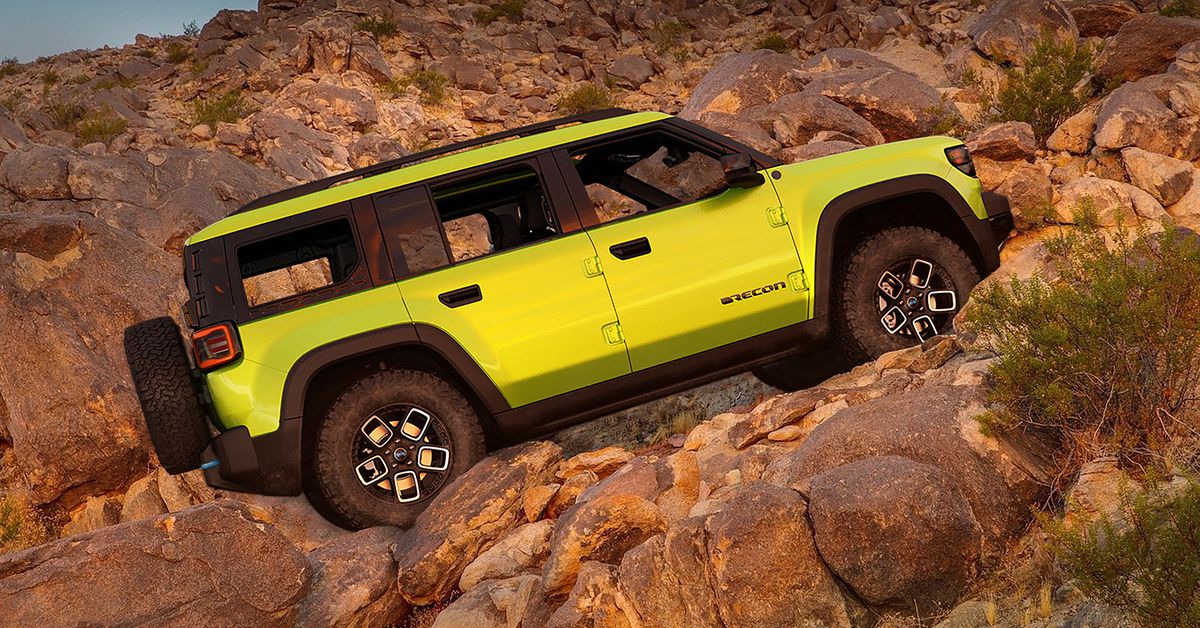Earlier this week, Stellantis CEO Carlos Tavares took the stage at the Bernstein investor conference and threw down the gauntlet.
Tavares, who oversees companies like Fiat, Chrysler, Dodge, Ram, and, most importantly, Jeep, said the launch of the new all-electric Jeep Wagoneer S would signal the start of an EV “offensive” that would take the US by storm, according to multiple reports. And part of that offensive would include a more affordable electric Jeep, priced somewhere in the range of $25,000.
For Jeep CEO Antonio Filosa, the announcement from his boss came as a bit of a shock.
“It’s a big challenge,” Filosa said Thursday, hours after unveiling the Wagoneer S in New York City. “And unexpected.”
Unexpected — and perhaps also a little awkward. After all, the Wagoneer S, with its premium materials, high-tech components, and impressive performance capabilities, is very much not an affordable EV. The fully loaded First Launch edition will start at $71,995 — not exactly a price meant to spur mass adoption.
Still, Filosa says Jeep will rise to the challenge. But how long will it take? Timing is of the essence. EV sales are still growing but at a slower pace than previous years. Buyers are more discerning. They’re looking for vehicles that are fast charging with plenty of range but also priced in a way that’s affordable. Most experts have said a $25,000 EV could help that line graph turn from a gentle slope into a hockey stick. But when it comes to exact timetables, only Tavares seems to know for now.
“It’s a big challenge. And unexpected.”
“My boss says soon,” Filosa said with a smile. “Obviously, its an engineering [challenge], so we need to put people [in charge of] developing the car. We have good ideas, we already had our calculation, and we strongly believe that we can get there. Strongly believe.”
Obviously, the project is still in its very early stages. While announcing the Wagoneer S, Filosa said the Wrangler-esque Jeep Recon would be revealed later this year. After that, a third unnamed vehicle will be announced the following year — though Filosa wouldn’t say whether it would be a battery-electric vehicle, plug-in hybrid, or perhaps both. “It will be affordable,” Filosa said, calling it “a smaller Jeep,” but likely not the $25,000 model referenced by Tavares.
Battery-electric vehicles represent a significant shift for Jeep, which has largely been focused on plug-in hybrid vehicles in the US. The company’s 4xe (pronounced “four by e”) hybrids, like the Wrangler 4xe and Grand Cherokee 4xe, are extremely popular, with PHEV sales up 124 percent in 2023 compared to the previous year.
Jeep also sells a compact electric SUV, the Avenger, in Europe for around 35,000 euros, or about $37,800. The company’s cheapest model, the Jeep Compass, starts at $25,900.
Indeed, for the broader industry, the $25,000 EV has been somewhat elusive. Tesla reportedly canceled its plans for a more affordable “Model 2” vehicle at the behest of Elon Musk, who is in the process of shifting the company’s resources toward building a fully autonomous robotaxi. (Musk later recommitted to building “affordable” models while studiously avoiding referencing the $25,000 price point.)
“We strongly believe that we can get there.”
Ford, Volkswagen, and Kia have all said they plan on producing smaller, more affordable EVs in the hopes of stirring up more demand among price-conscious shoppers. GM is relaunching its affordable Bolt EV on a new platform, while Nissan hasn’t said what the future holds for its pioneering Leaf hatchback.
Meanwhile, the specter of dirt-cheap Chinese EVs flooding the market has many automakers nervous — Filosa included. Companies like BYD, Li Auto, and Nio have been exporting plug-in vehicles with aggressive pricing to Africa, South America, and Europe. The Biden administration thinks tariffs can stop them from coming to the US, but that just may delay the inevitable.
“I worry because the level of cost that they need is 20–25 percent lower than our costs,” Filosa said of BYD and other Chinese automakers. “Obviously, I’m talking of challenges coming, and it will challenge us to get better.”

